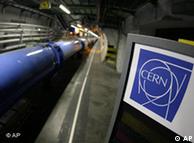On Tuesday 30 March 2010, at 13.06 local time in Geneva,
Switzerland, CERN's Large Hadron Collider (LHC) broke scientific
boundaries. The LHC slammed beams of particles together at a record
collision energy of 7 tera-volts, that's seven billion electron volts
- three and a half times faster than ever achieved before in a particle
accelerator. This will allow them to recreate conditions shortly after
the so-called Big Bang conditions that launched the universe 13.7
billion years ago.
"This is a step into the unknown,” said CERN research director Sergio
Bertolucci.
"We are doing something that no one has done before. We hope to find
things that are really new,” Bertolucci said.
Working towards this moment for 25 years
The Large Hadron Collider, the world's biggest particle accelerator,
is 27-kilometers long. The entire project has so far cost around seven
billion euros ($9.4 billion). A similar attempt to collide particles in
the Large Hadron Collider failed in 2008. After Tuesday's successful
experiment, scientists can now move into uncharted territory.
"It's been a fabulous day," James Gillies, the head of communication
for CERN told Deutsche Welle.
"Scientists at CERN have been working towards this day for 25 years.
This is something that comes around once in a career, when new research
can change the way we view the universe. 10,000 scientists around the
world, 2,500 students with PHD's have been waiting for this day so they
can further their work."
 Bildunterschrift: Großansicht des Bildes
mit der Bildunterschrift: Particles
travel at almost the speed of light through the LHC's 27-km tunnel
Bildunterschrift: Großansicht des Bildes
mit der Bildunterschrift: Particles
travel at almost the speed of light through the LHC's 27-km tunnel
Understanding dark matter and black holes
Data from collisions over the next few years will be analyzed by
thousands of scientists who are linked by a global computer network
known as "The Grid". Gilllies said they are especially keen to explore
dark matter.
"Now we believe that about 25 percent of the universe is made up of
stuff called dark matter, and we know nothing about it. We know it's
there because of the influence it has on galaxies and so on, but we
don't know what it is,” Gillies said.
The Hadron Collider can smash protons together so hard, that
physicists expect to be able to identify a mechanism called the Higgs
Boson within a couple of years and evaluate its physical properties. The
Higgs Boson is said to explain the nature of dark matter and black
holes.
James Gillies dismissed fears that the LHC could blow up the planet
while scientist go around creating micro-black holes.
"That is not what it's all about.That's a lot of hype coming from
various places. We are not going to create earth-eating black holes,” he
said.
Do black holes seep from the forces of gravity?
The force of gravity is believed to be a key factor in understanding
the formation of black holes.
"You and I can defy gravity by jumping in the air, but you can't defy
gravity for long,” Gilllies said.
"If you wanted to defy the next weakest force of nature after
gravity, it would involve you walking through walls. Well, you are not
going to do that. So, physicists want to understand why gravity is so
weak. "
Gillies said that some theoreticians believe that the forces of
gravity are weak, and that some of its energy is in fact leaked outside
of the three dimensions that we commonly know.
"That is mind-boggling to think of it. Mathematically it all hangs
together very well," Gillies said.
"Some theories say that when we bang our protons very hard together
in the LHC, we'll be pushing them so close together, that gravity
becomes as strong as the other forces and we see the extra dimensions of
gravitational effects. These theories predict that we might produce
objects that are called microscopic black holes."
Author: Wilhelmina Lyffyt
Editor: Susan Houlton
http://www.dw-world.de/dw/article/0,,5414712,00.html









